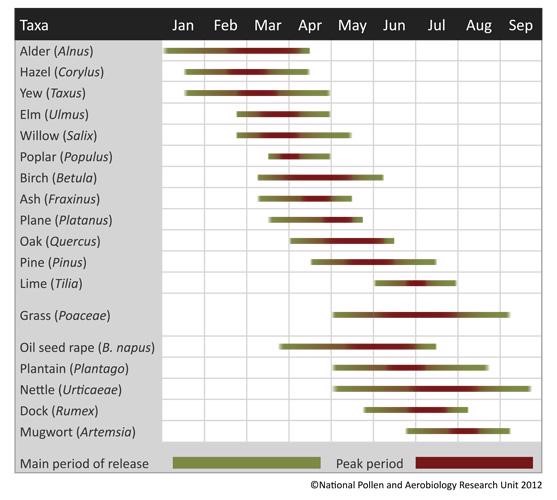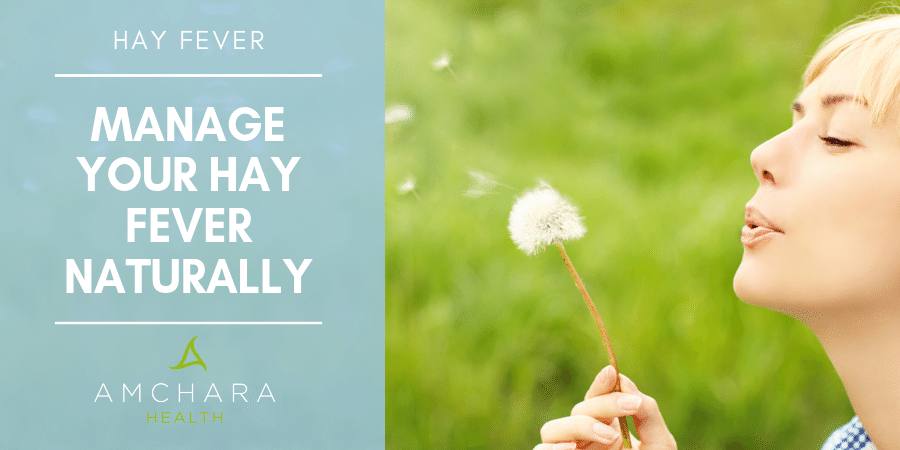One in five people in the UK suffer from hay fever.
During the spring and summer months it can cause much disruption to a sufferer’s day to day life.
The conventional approach to hay fever includes taking medications designed to treat the symptoms – whilst these may offer some relief from troublesome symptoms they often come with side effects such as drowsiness, headaches and dry mouth.
Fortunately, there are natural solutions to assist in hay fever.
In this article we take a look at hay fever in more depth and discuss natural options available.
What is Hay Fever?
Hay fever is also known as seasonal allergic rhinitis, and involves immune hypersensitivity to airborne allergens such as grass, flower or tree pollen.
As the immune system over reacts to the allergen, a cascade of reactions occur within immune cells resulting in the production of inflammatory molecules and histamine.
Histamine can be useful in the body as it plays a role in directing white blood cells, but it is when histamine is produced in excess that signs and symptoms are seen.
Typical symptoms seen in hay fever include:
- Blocked, stuffy nose
- Runny nose
- Red, itchy watery eyes
- Swelling around the eyes
- Sneezing
- Build up of mucus – catarrh
- Itchy throat
- Temporary loss of smell or taste
The severity of symptoms may vary according to each person and it may occur at different points of the year depending on which allergen is causing a problem.
When does Hay Fever occur?
Traditionally hay fever occurs between the months of May to September, although it may start earlier in the year if the weather is particularly warm.
If you feel your symptoms occur earlier in the year you are more likely to be sensitive to tree pollen, whereas if your symptoms occur a little later in the summer it may be mugwort or nettle pollen you react to.
Symptoms that occur all year round are called perennial allergic rhinitis and in this situation the allergen is more likely to be moulds, dust mites or pets.

What are the Contributing Factors?
There can be a variety of contributing factors and for some people it may take one or two factors to increase the chance of reacting, whereas for others several factors may need to be present.
- Food intolerances, especially to dairy products (1)
- Sensitivity to food additives and colourings
- Airborne moulds and spores
- Air pollution including traffic fumes
- Cigarette smoke
- Stress (2)
- Genetics (3)
- Climate change (4)
What are the Nutritional Solutions for Hay Fever?
Nature has provided an abundance of beneficial molecules in food and the introduction of highly processed convenience foods may be contributing to imbalances in several nutrients that the immune system relies on for correct functioning.
Returning to preparing and eating fresh foods is a great place to start.
Nutritional alterations are targeted at rebalancing the immune system, reducing histamine and lowering inflammation.
- Aim to eat 8-10 portions of fresh fruit and vegetables a day – with an emphasis in vegetables. All plants are rich in beneficial antioxidants which help to curb the inflammatory response and supply nutrients to support immune functioning. Choosing a wide variety of fruits and vegetables is best as this ensures a more diverse range of nutrients are eaten. Keeping a fruit and vegetable intake chart or using a rainbow food wheel to track daily intake can be useful
Some nutrients are of particular use in hay fever.
These include:
- Quercetin is a bioflavonoid found in foods such as onions, apples, cranberries, elderberries, blueberries, kale and spinach. It has been shown to stabilise the cell wall of histamine releasing cells so that histamine is not released (5). It also has anti-inflammatory properties and so may be useful for symptoms such as a stuffy nose or a rash.
- Vitamin C has a variety of functions within the body and works synergistically with quercetin. One of vitamin C’s most well-known functions is in supporting the immune system, but it also has natural anti-histamine effects (6) and helps airways to respond better during histamine release (7). Many fruits and vegetables are rich in vitamin C but it is particularly high in guavas, strawberries, citrus fruits, broccoli, peppers and kiwi.
- Bromelain is a protein-digesting enzyme found in pineapples. It aids in the absorption of quercetin and also has anti-inflammatory properties (8). It may be particularly useful for breaking down mucus, which is often associated with allergies.
Juicing can be a useful way of increasing nutrient intake from fruits and vegetables and fresh juice should be consumed immediately to ensure there is no breakdown of the nutrients.
Juicing also helps to cleanse the body and supports elimination of toxins that may be affecting the immune system.
- Include oily fish at least 3 times a week – mackerel, sardines, pilchards, salmon, herring, trout and tuna are all rich in the omega-3 essential fats. These fats are precursors to natural anti-inflammatory molecules and actively work to reduce inflammation in the body (9).
- Walnuts, flax and hemp oil all contain a vegan type of omega-3 and can be added to smoothies, juices or salads.
- When looking at reducing inflammation through omega balance it is advisable to avoid processed foods which are often high in omega-6 fatty acids. The omega-6 fatty acids can compete with omega-3 for breakdown which leads to an increase in inflammation.
- Reduce inflammatory foods – red meat and dairy contain substances that may alter the essential fat balance and therefore may influence inflammation. It may be useful to monitor your beef, lamb, pork and dairy intake and opt for organic grass-fed meat which contains more of the anti-inflammatory omega-3 fats (10). Swapping red meat for white fish, oily fish or legumes and pulses can further reduce inflammatory molecules.
- Avoid charred, fried foods and those containing trans fatty acids, these directly influence inflammation and generally are low in beneficial nutrients. Good cooking methods include steam frying, slow roasting, poaching or baking.
- Reduce high histamine foods – cocoa, coffee, alcohol, dairy foods, soy products, processed meats, smoked and tinned fish and fermented foods such as sauerkraut, kefir and ripened cheese are best kept to a minimum to reduce overall histamine levels.
Specific Nutritional Supplements
From time to time it may be helpful to take high quality, excipient (binder or filler) free nutritional supplements to support the immune system in the run up to and during the hay fever season.
These can include:
- Quercetin, bromelain and vitamin C – available as supplements and can be useful alongside dietary sources.
- Beta glucans 1,3/1,6 – comes from oyster mushrooms and has a large role to play in immune responses. It has been shown to modulate specific parts of the immune response that may favour hay fever (11). An oral supplement of beta glucans 1,3/1,6 has been shown to reduce hay fever symptoms (12).
- Probiotics – the gut houses over 70% of the immune system and the beneficial bacteria that reside in the gut, also called the microbiome , are known to play a role in immunity and inflammatory pathways. Specific bacteria such as Bifidobacterium longum, Lactobacillus acidophilus and Bifidobacterium lactis are of benefit in hay fever (13, 14) and reduce inflammatory responses as well as respiratory symptoms.
- MSM – a sulphur-containing compound that aids in keeping cell structures strong and may contribute to a healthy respiratory system. It is thought to have anti-inflammatory properties and acts as a natural anti-histamine. Supplementation during the hay fever season has been shown to ease symptoms (15).
Halotherapy
Salt has been used for centuries as an aid for the respiratory tract.
Breathing in salt saturated air has been shown to thin the sticky thick mucus that may build up in the respiratory tract and make it easier to eliminate (16).
Halotherapy rooms with salt saturated air can be used to alleviate respiratory mucus issues and a salt pipe can be used at home.
A salt pipe is a porcelain pipe that holds a specific type of salt, gentle inhalations are made through the pipe for 5-15 minutes a day.
Using a salt inhaler can be a very effective drug free way to manage hay fever (17).
What Lifestyle Alterations can be made for Improvement?
Alongside reducing inflammation, tackling histamine release and balancing the immune system there are many lifestyle alterations that can be taken in order to reduce exposure to potential allergens.
Here are our top suggestions:
- Avoid going out at peak pollen times – first thing in the morning and in the early evening
- Keep doors and windows shut on high pollen count days
- Wear wrap-around sunglasses to help keep pollen out of the eyes
- Wear a pollution mask when cycling, walking or exercising near busy city roads
- Apply a natural barrier around nostrils, such as a beeswax based balm
- Wash your face and hands regularly
- Change clothes when coming inside and shower to remove specks of pollen
- Go to the seaside to take advantage of pollen free, salt enriched air
- Get good sunlight exposure – at least 20 minutes a day on skin to ensure a good level of vitamin D is synthesised – a low vitamin D level may increase hay fever (18)
- Avoid sitting or rolling on the grass during pollen season
- Avoid drying washing outside on high pollen count days
- Avoid having plants in your garden that you know you react to
- Avoid mowing grass
- Buy an allergy approved vacuum cleaner and clean carpets regularly
- Make sure house is well dusted with a microfibre cloth or damp cloth
Being prepared in the run up to the hay fever season can significantly reduce symptoms in the warmer months.
If you suffer from hay fever then starting to make some of these natural preparations around 2-3 months before you normally experience symptoms can aid in boosting immune function and reduce hypersensitivity when pollen levels become high.
If you are unsure what triggers your allergy symptoms a personalised consultation with an experienced practitioner can help to guide you on the best course of action to remedy symptoms.
Using a functional medicine approach including a full case history, family background and functional tests allows for a personalised programme to be designed with your specific needs in mind.
We’re dedicated to providing you with both insightful information and evidence-based content, all orientated towards the Personalised Health approach.
Did you find this article useful?
We would love to know your thoughts.
Let us know your top tips to help with hay fever symptoms.
READ THIS NEXT:




